INTRODUCTION
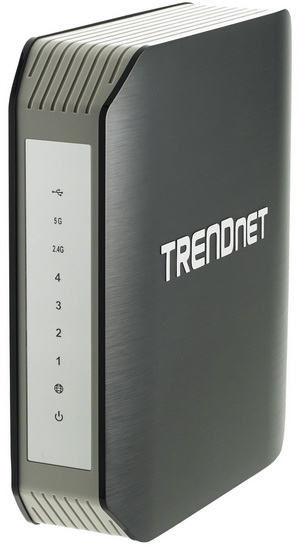
When the Wireless N (802.11n) compatible routers first came out in the market slightly over 5 years ago things were quite simple since the majority of manufacturers didn't focus in the development of many such models (with a maximum speed of 600Mbps that didn't come as a surprise really). Some models using two Wireless-N concurrent signals that topped up to 750Mbps did make their appearance but their number weren't enough to draw much attention. Well all that changed with the appearance of the much faster Wireless AC (802.11ac) standard just over a year ago simply because since then we've witnessed the appearance of not one but several different models with support for different total speeds. So although the very first models supported up to 750Mbps (433+300Mbps) the ones that followed supported (and still do) up to a total of 1200/1300/1600/1750/1900/AC2350/2400/AC3200Mbps via two concurrent signals (chances are we will see even more). Today’s review is about one such product so with us today we have one of the latest AC1900 compatible router models to hit the market, the TEW-818DRU by TRENDnet.
Founded in Torrance, California, TRENDnet has grown to become a leading global networking hardware brand. From the network core to the periphery, TRENDnet's expansive product portfolio includes Wireless, Wired, Surveillance, Connectivity, and Peripheral device categories. An emphasis on continual improvement and our ISO 9001:2008 quality management certification (click here to view certificate) is an essential component of TRENDnet’s success. The TRENDnet brand is consistently recognized for exceptional quality, superior performance, and responsive support. TRENDnet's vision is to build innovative, easy to use, and reliable Networks People Trust™. TRENDnet solutions network the countless devices which enable your connected lifestyle and workplace. Building award winning networking solutions since 1990, TRENDnet connects you with what you value most.
The TEW-818DRU is not much different compared to the TEW-812DRU which we reviewed slightly over a year ago but TRENDnet did upgrade it quite a bit so this time over under the hood we find the Broadcom BCM4708A (1 GHz dual-core ARM® Cortex™-A9 CPU) and the BCM4706 communication processors along with 128MB RAM, 16MB of onboard flash memory and three internal dual-band antennas (numbers which i have to admit are not as high as some other routers and thus may affect performance). The TEW-818DRU also supports TurboQAM to boost Wireless-N speeds (only compatible with Broadcom BCM4335 based receivers however), is compatible with DD-WRT (some custom firmware’s are already available) and features a total of 2 USB ports (USB 2.0 & USB 3.0). The how well it performs and what functions it offers well those are things we're about to find out.
SPECIFICATIONS AND FEATURES


PACKAGING AND CONTENTS
TRENDnet has placed a large product picture at the front right above some of the features it offers.
The product features and package contents are listed on the right side.
A comparison table between two Wireless-AC compatible routers and the TEW-818DRU is placed at the rear.
The serial number and barcode for the product are placed at the base of the box.
In the box you will find the TEW-818DRU router, wall power adapter, Ethernet cable, software CD and the quick start guide.
THE TEW-818DRU
Standing 180mm tall, 155mm wide and 48mm thick the housing of the TEW-818DRU is identical to that of the TEW-812DRU.
TRENDnet has placed their logo on both sides.
Once again the activity LEDs for the Ethernet ports, Internet, Wireless and USB storage are all placed at the front of the device.
The housing is perforated at the top and bottom to allow hot air to exit from the interior easier.
Moving at the rear we see 4 Gigabit LAN ports, WAN port, WPS button, On/Off switch, one USB 2.0 port and one USB 3.0 port.
You can find the SSID, wireless key, user name and password of the device on a sticker placed at the base.
WEB INTERFACE PART 1
As usual one of the first things you should do is download the latest available firmware update from the official TRENDnet support page.
Lately TRENDnet has been using the same type of web interface for their products which is very easy to navigate and ontop of that looks quite good. The main tab once you access the web interface gives you a summary of the status of the device.
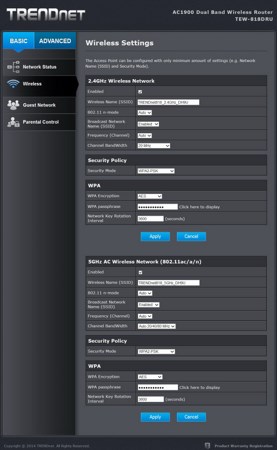

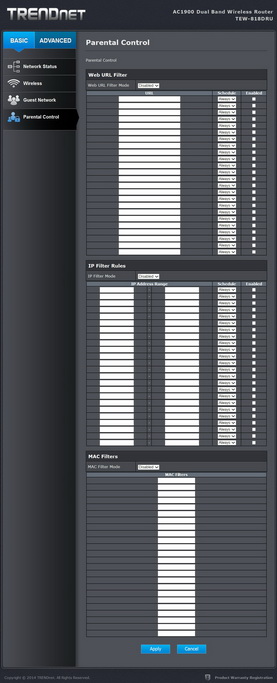
Via the basic tab you are allowed to change the various wireless settings, enable/disable the guest network and use the parental control feature to block URLs and IP addresses.
WEB INTERFACE PART 2

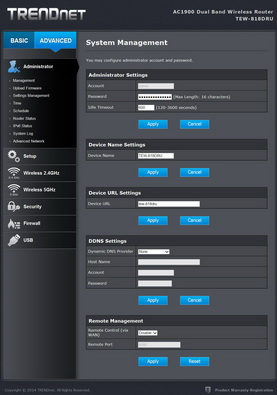
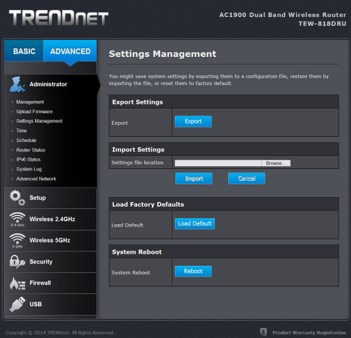
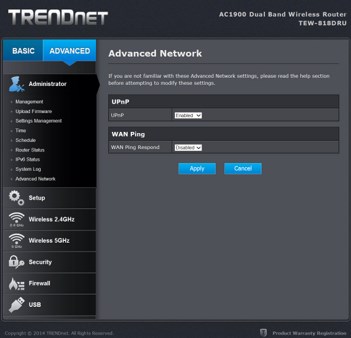
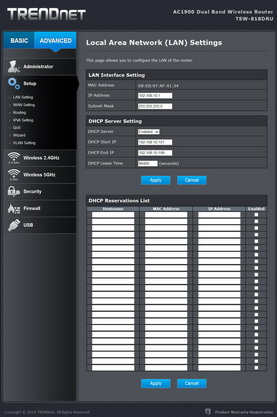
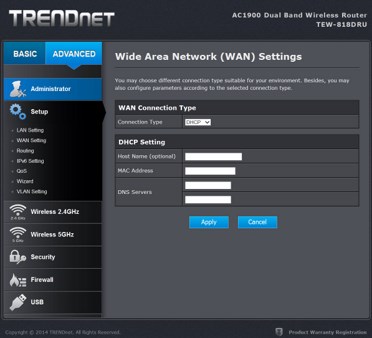
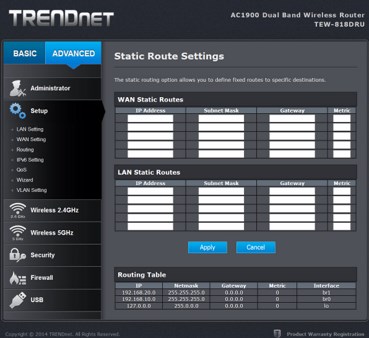
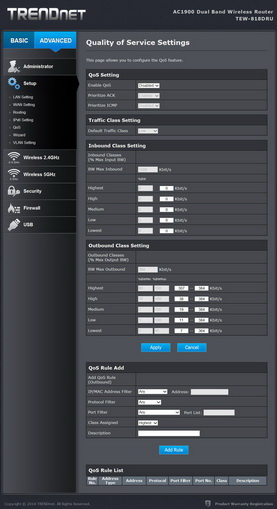
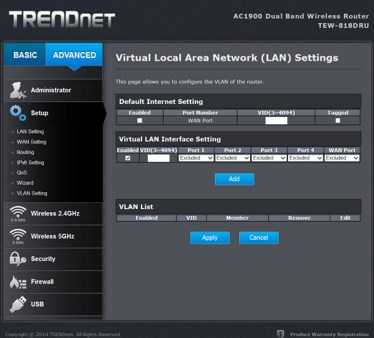
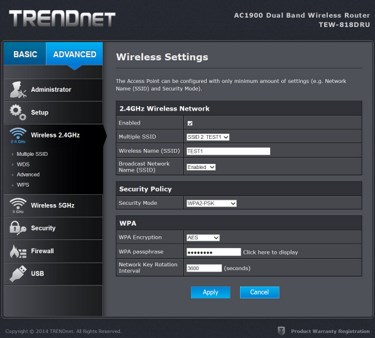
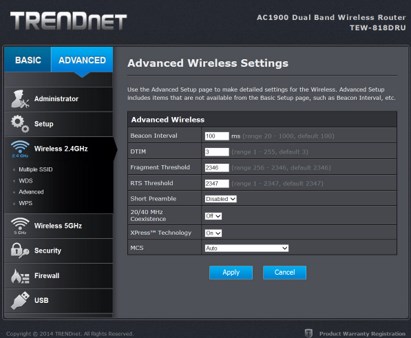
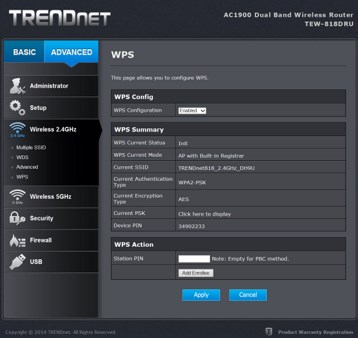
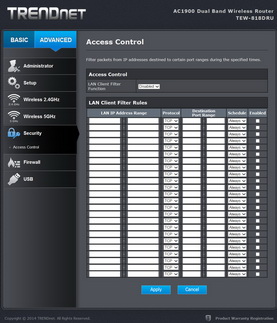
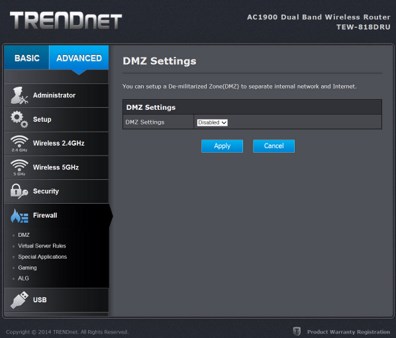
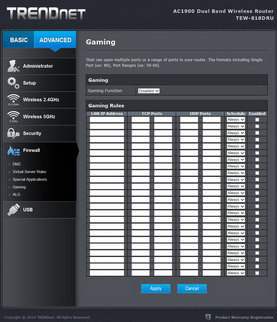

Through the advanced tab you can check the information screen, adjust the administration settings, export all settings to a file and/or reset the device back to its factory state, enable/disable UPNP and WAN ping, setup DHCP, access WAN settings, modify static route settings, setup the QoS (quality of service) feature, use the virtual LAN feature, enable two extra SSIDs on each radio band (four in total), configure WPS, setup access control, use DMZ, open ports used by games and you can also setup SAMBA and FTP servers for attached storage via USB.
TESTING METHODOLOGY
Since standalone routers can't directly connect to the internet (unless you have a cable connection which we don't) and thus the modem is responsible for internet speeds the only thing that's left is to test and see how much bandwidth they can offer by directly linking two devices with them. So once again we will be using the networking benchmark by Passmark (v.8), the QCheck by Ixia and ATTO 2.47 (since April 2015) to test such devices the same exact way we test Powerline adapters and Modem/Routers. Since we need to test new features and specifications all routers are benchmarked with their highest available wireless standard/band (5GHz in this case). Our systems are placed 15m away from the router with 3 concrete walls between them while each test is repeated a total of 6 times after which the average scores are recorded into our charts. Both systems have Windows 7 Ultimate SP1 installed with all the updates until the 17th of April 2015.
TEST RESULTS


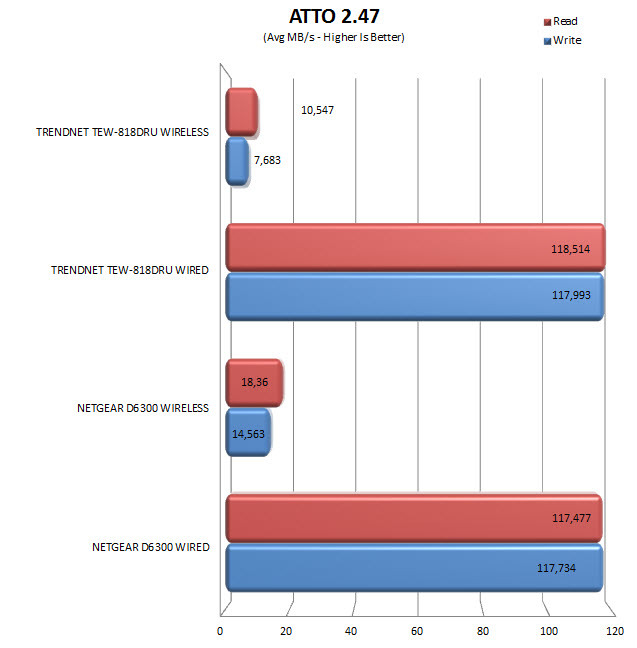 As you can all see from this point and forward we will also be using ATTO to test modem/routers since we feel that just Passmark and Ixia may not be sufficient for some of you. With that out of the way the TEW-818DRU may not be as fast as the R7000 by Netgear or the WRT1900AC by Linksys but it does come very close to the D6300 and although I did expect more I’m certain that the amount of RAM and flash memory may be responsible.
As you can all see from this point and forward we will also be using ATTO to test modem/routers since we feel that just Passmark and Ixia may not be sufficient for some of you. With that out of the way the TEW-818DRU may not be as fast as the R7000 by Netgear or the WRT1900AC by Linksys but it does come very close to the D6300 and although I did expect more I’m certain that the amount of RAM and flash memory may be responsible.
CONCLUSION

Modem/Routers using the latest 802.11ac standard offer a real step up compared to the previous generation 802.11n models but unfortunately not all are created equal so as you can clearly see from our charts the TEW-818DRU is really no match for the R7000 Nighthawk by Netgear and the WRT1900AC by Linksys (all three are AC1900 compatible ones). Now i don't know if that is due to the internal antennas used or because of the low amount of RAM and flash memory TRENDnet decided to equip it with but whichever is responsible (or both) i think that they can do a lot better (their latest AC3200 seems to resolve these issues). Once again we did like the web interface since it’s very easy to use and offers a plethora of available settings (more than enough for most people) but personally i think that TRENDnet should squeeze a few more settings under the basic tab since i feel that it's very limited. An notification feature in case a new firmware update is available (much like the one Netgear offers) would be a good addition as well although i don't think it's really very hard for people to check the downloads page every once in a while.
Retailing at a price of USD139.99 inside the USA (Amazon.com) and for 175.63Euros inside the EU (Amazon.de) the TEW-818DRU AC1900 Dual Band Router by TRENDnet may not be the fastest model in the market but it's priced roughly 25% less compared to the Netgear R7000 and 45% less compared to the WRT1900AC by Linksys inside the USA. Things inside the EU are not as good since the Netgear R7000 is actually cheaper (almost 10%) and thus is a better choice overall but the Linksys WRT1900AC is still more expensive (almost 25%). Of course if you're after the best possible wireless performance and available features chances are you will be after one of the latest AC3200 models. However if price is a concern unless you are in a position to get the faster and more solid R7000 Nighthawk by Netgear (for less) then the TEW-818DRU by TRENDnet is a very good choice since it offers a good price/performance ratio and that's why it gets our Golden Award.
 PROS
PROS
- Overall Quality
- Size
- AC1900 Technology (Concurrent 802.11n & 802.11ac)
- User Friendly Web Interface
- Good Set Of Features
- Supports TurboQAM/DD-WRT (Open Source OS)
- 4 Gigabit Ethernet Ports
- 2 USB Ports (USB 3.0 & USB 2.0)
- Price (USA)
CONS
- Price (EU)

 O-Sense
O-Sense





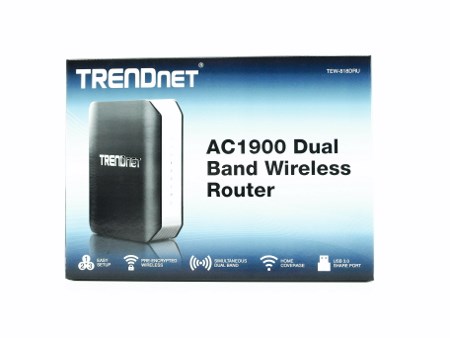
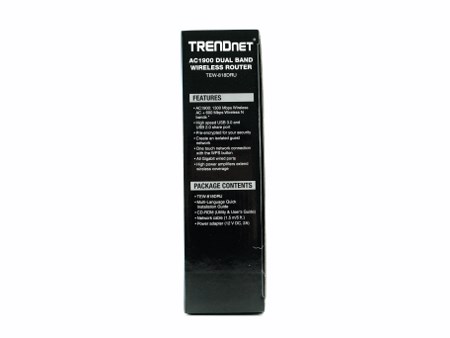
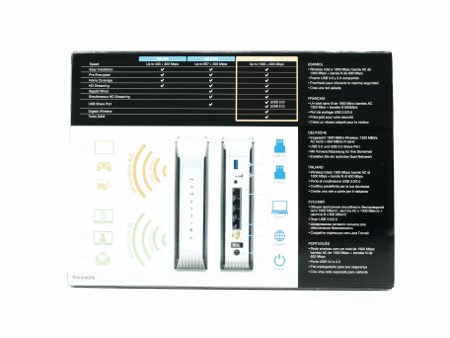

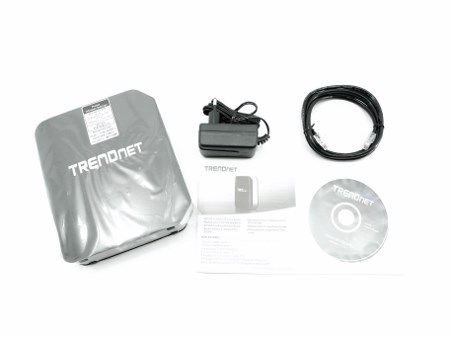
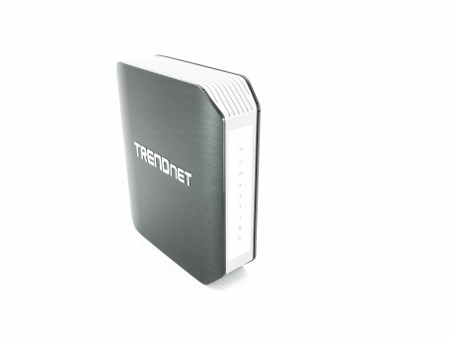
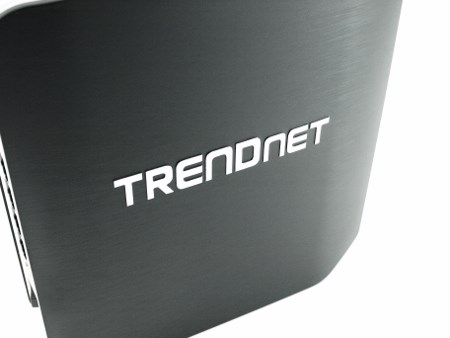
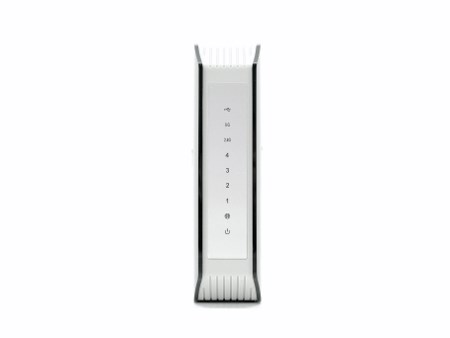
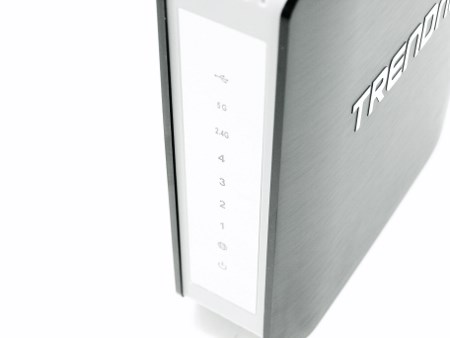
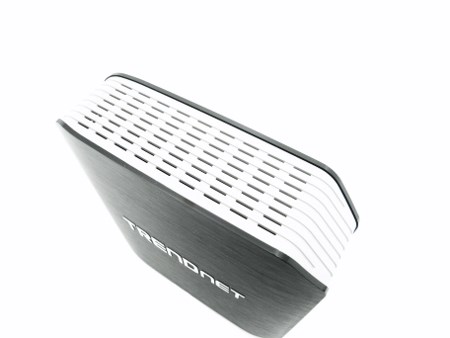
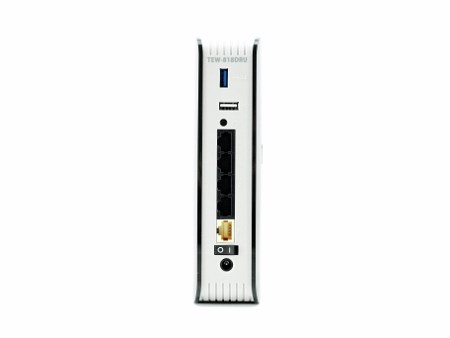
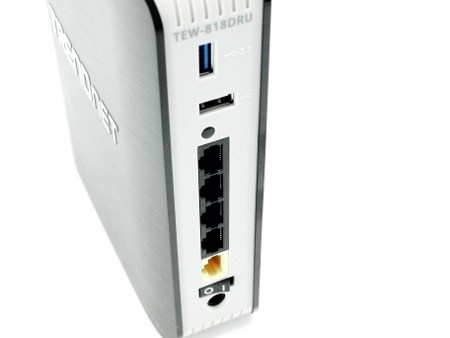

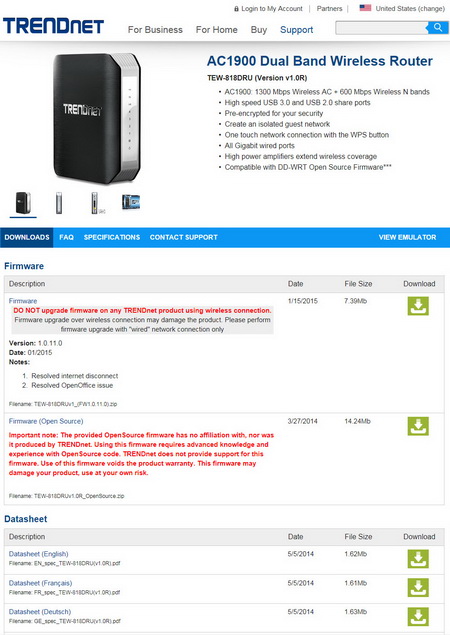
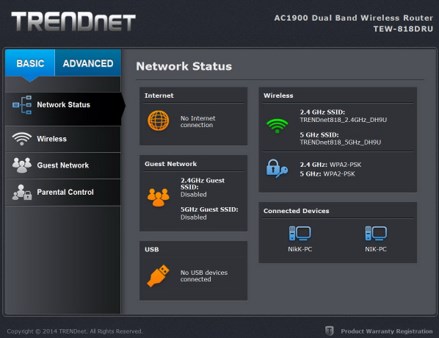


.png)

